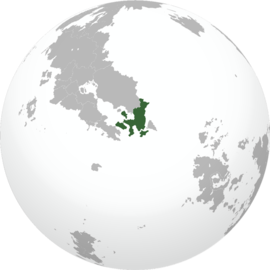the Cape
Cape National Republic Restarka Nationalista do Kabo | |
|---|---|
Motto: O, true, free, and mighty Cape! | |
 Location of the Cape (dark green) | |
| Capital and largest city | Cape Town |
| Official languages | Cape Coscivian |
| Recognised national languages | Kiravic Coscivian, Cartadanian |
| Government | Federal parliamentary constitutional republic under a provisional military government |
• President(s) |
|
| Kil Furey | |
• Marshal of the Stanera | Nancy Pellise |
• Procurator-General | Mitch Whalen |
| Legislature | Federal State Assembly |
| Procuracy Council | |
| National Stanera | |
| Independence from Kiravia and Cartadania | |
• Declaration of the Federacy | October 7, 1891 |
• Occupation of the Cape | May 12, 1938 |
• Republican restoration | October 7, 1951 |
| Population | |
• Estimate | 127,912,766 |
| GDP (nominal) | estimate |
• Total | $4.51 trillion |
• Per capita | $35,544 |
| HDI (2021) | very high |
| Currency | Cape Saer (₴) |
| Driving side | right |
The Cape, officially the Cape National Republic, is the easternmost country in Crona. It is bordered on the north, east, and south by the Odeneru Ocean and the Cathay Ocean. It covers __km2 and has a population of over 127 million people, largely concentrated in its namesake Cape Peninsula. The Cape is a multiethnic and multicultural society, with a majority of the population having mixed ancestry between the country's three primary ethnic groups, Kiravian, Cartadanian, and Cronan. The capital and largest city is Cape Town, which anchors the largest metropolitan area on the continent. It is comprised of seven provinces.
For thousands of years the Cape was home to various indigenous peoples, however, beginning in the 1600s, Cartadanian and Kiravian explorers began to settle the eastern coast of the country. A variety of independence movements and conflicts would mar the expanding colonies and dominions throughout the 18th and 19th centuries. Following a multiethnic War of Independence led by Melvyn Kalma and the nascent Republican Nationalist Party, the Federacy of the Cape gained independence as the first democracy on the continent proper of Crona in 1891. The tumultuous young democracy, weakened by political violence and rampant power struggles, was invaded and occupied by the Austral Democratic People's Republic during the Great War. A Second War of Independence took place, leading to the establishment of the one-party National Republic in 1951. A slow series of reforms throughout the decades has softened the hardline survivalism of the National Republic - with the country enjoying its first free elections since occupation in 1997.
The Cape is a federal parliamentary constitutional republic, with a non-executive president serving as head of state and a Prime Executive serving as head of government. Although reforms have nominal disestablished the one-party rule of the Republican Nationalist Party, the National Republic today is still a much less democratic state than the Federacy that preceded it. While nominally a multi-party democracy, the Cape is still dominated by the RNP and its Restarkist ideology. It ranks as a semi-democracy in the Liberty Index, and is considered by both domestic and foreign critics as an authoritarian democracy. Since the 2021 Cape coup d'état, the nation's presidency has been occupied by the Armed Forces Council until the 2024 elections. The Cape is a member of numerous international organizations such as the League of Nations.
The Cape is described as regional power with a growing economy and a highly developed market. The economy, although traditionally fuelled by the state-led exploitation of natural resources, manufacturing, and international shipping, has grown significantly in the service sector during the past two decades. Cape Town and its environs continues to rank as one of the most important Cronan urban areas, home to the continent's largest stock and commodity exchanges by market capitalization. The nation has high levels of economic freedom yet maintains numerous state-provided social services.
Etymology
The Cape is named after the Cape Peninsula and its landmark Cape of the Segunda Cabeça. As a great cape seen as the final waypoint between the Odeneru and the Cathay, sailors and settlers began to refer it as simply "the Cape". The name stuck, and the Kiravian colony that would be eventually founded there took on the name Axerka Kesta (literally "cape colony"). Over the decades, the name came to become the regional designator for the colonies and states of far southern Crona. When those states were federated and granted independence, the Federacy of the Cape was the name chosen.
The Cape is one of a handful of countries in which the definite article is used in its English-language name, other than cases in which the name is plural or includes the form of government. The article is used by the nation's government and international authorities, and has entered into common colloquial use when referring to the country.
History
Indigenous peoples
Occidental colonization
Independence and confederation
20th century
Contemporary era
Geography
Administrative divisions
Politics and government
The Cape National Republic is organized as a federal parliamentary constitutional republic, comprised of seven provinces in a symmetric federation. It is a representative democracy with traditions of secularism, social justice, and egalitarianism.
Law
Foreign relations
Military
Nuclear weapons and the Cape Commission for the Preservation of the Republic

